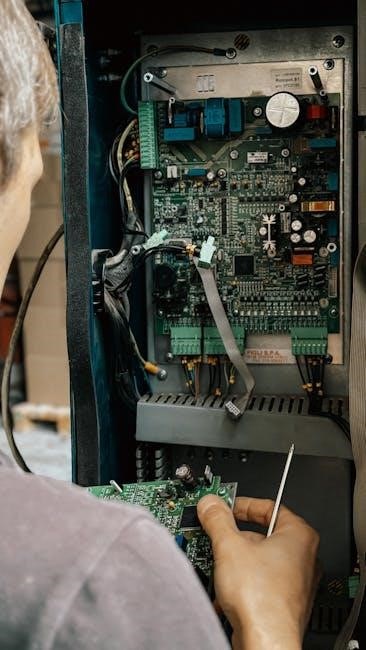Evinrude Owners Manual: A Comprehensive Guide
Welcome to the definitive resource for your Evinrude outboard motor! This manual provides detailed instructions,
maintenance schedules, and troubleshooting guidance for optimal performance and longevity;
Evinrude has a rich history of innovation in outboard motor technology, dating back to the early 20th century. Known for their reliability, power, and advanced features, Evinrude motors have become a trusted choice for boaters worldwide.
This section will familiarize you with the core principles behind Evinrude’s engineering. Understanding these fundamentals will enhance your ability to maintain and operate your motor effectively. We’ll briefly touch upon the different types of Evinrude engines – from classic two-stroke designs to the modern E-TEC technology – highlighting their unique characteristics.
Proper operation and maintenance are crucial for maximizing the lifespan and performance of your Evinrude outboard. This manual serves as your guide, providing clear instructions and valuable insights to ensure a safe and enjoyable boating experience. Familiarize yourself with the terminology and components discussed here, as they will be referenced throughout this comprehensive guide.
Understanding Your Evinrude Model
Each Evinrude outboard motor is a unique system, tailored to specific boating needs. Identifying your exact model is the first step towards proper care and maintenance. Locate the model and serial number plate – typically found on the engine bracket – and record this information for future reference.
This section will guide you through deciphering the key components specific to your Evinrude. We’ll cover the location of essential parts like the fuel pump, carburetor (or fuel injection system), and electrical connections. Diagrams and illustrations will aid in visual identification.
Understanding the specifications of your engine – horsepower, shaft length, and gear ratio – is vital for selecting the correct parts and accessories. Refer to your engine’s documentation or the Evinrude website for detailed specifications. Knowing these details ensures optimal performance and prevents compatibility issues.

Essential Maintenance Procedures
Proactive maintenance is crucial for a reliable Evinrude experience! Regular checks and timely servicing will maximize performance, extend engine life, and prevent costly repairs.

Regular Inspection Checklist
Before each use, a thorough inspection is paramount for safe and efficient operation. Begin by visually examining the engine for any loose or damaged parts, paying close attention to fuel lines, electrical connections, and the propeller.
Check the oil level in both the engine and gearcase, ensuring they are within the recommended ranges. Inspect the cooling water intake for obstructions, and verify proper water flow during operation.
Furthermore, examine the steering system for smooth and responsive control. Confirm the throttle operates freely and returns to idle position correctly. Inspect the fuel tank for leaks or damage, and check the fuel filter for any signs of clogging.
Don’t forget to verify the operation of all safety features, including the emergency shut-off switch. A consistent pre-operation checklist will help identify potential issues before they escalate into major problems, ensuring a worry-free boating experience.
Fuel System Maintenance
Maintaining a clean and efficient fuel system is crucial for optimal engine performance. Regularly inspect fuel lines for cracks, kinks, or leaks, replacing them as needed. Ensure the fuel filter is clean and free of debris; replace it according to the manufacturer’s recommendations, typically annually or after a specified number of operating hours.
Periodically check the fuel tank for water and sediment accumulation. Drain any accumulated water to prevent corrosion and fuel delivery issues. When storing the engine for extended periods, stabilize the fuel to prevent degradation and varnish formation.
Pay attention to any signs of fuel leaks or unusual odors, addressing them immediately. A well-maintained fuel system ensures reliable starting, smooth operation, and prevents costly repairs. Remember to always use fresh, high-quality fuel appropriate for your Evinrude model.
Fuel Tank & Lines
The fuel tank and lines are the foundation of your Evinrude’s fuel delivery system. Inspect the fuel tank regularly for signs of corrosion, damage, or leaks. Ensure the tank vent is functioning correctly to allow proper airflow and prevent vacuum buildup. Fuel lines should be checked for cracks, kinks, or hardening, replacing them immediately if any issues are found.
Always use marine-grade fuel lines specifically designed for outboard motors, as they are resistant to ethanol and saltwater. Securely clamp all fuel line connections to prevent leaks. When disconnecting fuel lines, ensure the fuel supply is shut off and take precautions to avoid spills.
Periodically drain any water or sediment that may accumulate in the fuel tank. A clean tank and properly maintained lines are essential for reliable engine operation and preventing fuel-related problems.

Carburetor Care
The carburetor mixes air and fuel for optimal combustion. Regular cleaning is crucial for smooth engine performance. Deposits can build up, restricting fuel flow and causing starting or running issues. Disassemble the carburetor carefully, noting the position of all parts. Use carburetor cleaner specifically designed for marine applications to dissolve varnish and deposits.
Inspect all jets, passages, and the float for obstructions. A small wire can help clear blocked jets. Ensure the float is not damaged or leaking fuel. Reassemble the carburetor with new gaskets and seals. Proper adjustment of the idle mixture screw is vital for a stable idle speed.
If you are uncomfortable performing carburetor maintenance, consult a qualified marine technician. A well-maintained carburetor ensures efficient fuel usage and reliable operation.
Oil & Lubrication
Proper lubrication is paramount for extending the life of your Evinrude outboard. Friction causes wear and tear, and oil reduces this significantly. Your engine requires both motor oil for internal components and gearcase oil for the lower unit. Consistent oil changes, following the recommended intervals in your owner’s manual, are essential.
Neglecting lubrication can lead to catastrophic engine failure. Always check oil levels before each use and top off as needed. Use only oil that meets Evinrude’s specifications – using the wrong type can cause damage. Pay close attention to the gearcase oil; it protects the gears from corrosion and wear.
Regularly inspect for leaks and address them promptly. A well-lubricated engine runs cooler, smoother, and lasts longer, providing years of reliable service.
Oil Type Recommendations
Selecting the correct oil is crucial for your Evinrude’s performance and longevity. Evinrude engines typically require a high-quality, marine-specific two-stroke oil that is formulated for outboard motors. Always refer to your engine’s specific owner’s manual for the precise oil type and API rating recommended for your model year.
Using automotive oils is strongly discouraged as they lack the necessary additives to protect against the harsh marine environment. Synthetic oils generally offer superior protection and performance, especially in high-performance applications or extreme temperatures. For gearcase lubrication, utilize a specific gear oil designed for marine applications, typically an 80W-90 weight.
Ensure the oil meets the NMMA TC-W3 specification. Regularly check Evinrude’s website for updated oil recommendations, as formulations can change over time.
Gearcase Lubrication
Maintaining proper gearcase lubrication is vital for protecting the lower unit of your Evinrude outboard. The gearcase houses the gears that transmit power to the propeller, and insufficient lubrication can lead to premature wear and failure. Regularly inspect the gear oil for water contamination – a milky or cloudy appearance indicates water intrusion, requiring immediate attention.
Change the gear oil according to the schedule outlined in your owner’s manual, typically annually or after every 100 hours of operation, whichever comes first. Use only marine-specific gear oil of the recommended weight (usually 80W-90). When changing the oil, inspect the vent plug to ensure it’s clear of obstructions, allowing for proper pressure equalization.
Always dispose of used gear oil responsibly at a designated recycling facility. Proper gearcase maintenance significantly extends the life of your lower unit.
Cooling System Maintenance
Evinrude outboard motors rely on a robust cooling system to prevent overheating and ensure reliable operation. This system utilizes water to dissipate heat generated by the engine. Regular maintenance is crucial for optimal performance and longevity. Neglecting the cooling system can lead to severe engine damage.
Inspect the cooling water intake for any obstructions, such as weeds or debris, before each use. Ensure the telltale indicator is consistently flowing water while the engine is running. A weak or absent flow signals a potential problem. Periodically check all cooling hoses for cracks, leaks, or kinks, replacing them as needed.
Consistent flushing and impeller checks are paramount. Refer to the sections below for detailed instructions on these vital procedures. A well-maintained cooling system is essential for trouble-free boating.
Flushing the Cooling System
Regularly flushing your Evinrude’s cooling system removes salt, sand, and debris that can accumulate and cause corrosion or blockages. This is especially important after use in saltwater environments. Flushing should be performed after each outing, or at least monthly during periods of frequent use.
To flush the system, connect a flushing attachment (often called a “muffin”) to a garden hose and insert it into the flush port on the engine. Start the engine and allow it to run for 10-15 minutes, observing the exhaust for clear water. Avoid running the engine at high RPMs during flushing.
Ensure the boat is in a well-ventilated area during flushing. Disconnect the hose and inspect the water intake for any remaining debris. Proper flushing extends the life of your cooling system components and prevents costly repairs.
Impeller Inspection & Replacement
The water pump impeller is crucial for circulating cooling water through your Evinrude engine. Regular inspection and timely replacement prevent overheating and potential engine damage. It’s recommended to inspect the impeller annually, or more frequently with heavy use, especially in debris-filled waters.
To access the impeller, you’ll typically need to remove the lower unit of the outboard. Carefully inspect the impeller vanes for cracks, wear, or missing pieces. If any damage is found, or if the vanes are significantly worn, replace the impeller.
When installing a new impeller, lubricate the vanes with marine grease and ensure it’s oriented correctly. Reinstall the lower unit, following the manufacturer’s torque specifications. A worn or damaged impeller can lead to rapid overheating, so proactive maintenance is vital.

Troubleshooting Common Issues
Encountering problems with your Evinrude? This section offers solutions to frequently experienced issues, helping you diagnose and resolve them efficiently and safely.
Engine Won’t Start
A frustrating experience, an engine that refuses to start often stems from a few common culprits. First, verify the fuel supply – is the tank full and the fuel valve open? Next, check the kill switch; ensure it’s not engaged. Inspect the spark plugs for fouling or damage; a weak spark is a frequent offender.
Confirm the battery is fully charged and connections are clean and tight. A low battery can prevent the starter from engaging. Don’t overlook the primer bulb; it should be firm, indicating fuel is reaching the carburetor.
If these basic checks don’t resolve the issue, consider a faulty solenoid or a problem within the electrical system. Always disconnect the battery before working on the electrical components. A systematic approach, combined with this guide, will help pinpoint the cause and get you back on the water.
Poor Engine Performance
Experiencing a lack of power or rough running? Several factors can contribute to diminished Evinrude performance. Begin by examining the spark plugs – are they clean, properly gapped, and firing consistently? A weak spark significantly impacts engine output. Next, investigate the fuel system; a clogged fuel filter or restricted fuel lines can starve the engine.
Carburetor issues, such as dirt or varnish buildup, are common causes. Ensure the carburetor is clean and properly adjusted. Check the air intake for obstructions; a blocked air filter restricts airflow. Compression loss within the cylinders also leads to poor performance – a compression test is recommended.
Regular maintenance, including fuel stabilizer and carburetor cleaner, can prevent these issues. Addressing these potential problems systematically will restore your Evinrude’s power and efficiency.
Overheating Problems
Is your Evinrude engine running hotter than usual? Overheating can cause severe damage, so prompt attention is crucial. The most common culprit is a blocked cooling system. Inspect the water intake screen for debris – weeds, plastic, or sand can restrict water flow.
Next, check the cooling passages within the engine block for corrosion or buildup. A failing water pump impeller is another frequent cause; a visual inspection or a flow test will confirm its condition. Ensure the thermostat is functioning correctly, opening and closing to regulate coolant flow.
Regular flushing of the cooling system with fresh water is vital. Also, verify the exhaust system isn’t restricted. Ignoring overheating signs can lead to costly repairs. Address these issues immediately to maintain optimal engine temperature and prevent damage.
Electrical System Issues
Experiencing electrical problems with your Evinrude? These can range from a completely dead engine to intermittent sparking or charging faults. Begin by inspecting the battery connections – ensure they are clean, tight, and free of corrosion. A weak or failing battery is a common source of issues.
Check the wiring harness for damaged or frayed wires. Look for loose connections at the terminals and connectors. The ignition system, including the coil and spark plugs, should be tested for proper function. A faulty coil or worn spark plugs can cause misfires.
Don’t overlook the charging system! Verify the stator and rectifier/regulator are operating correctly to ensure the battery is being adequately charged. Use a multimeter to test voltage outputs. Addressing electrical issues promptly prevents further complications and ensures reliable engine operation.

Winterizing Your Evinrude
Proper winterization is crucial for protecting your Evinrude during the off-season. This process prevents corrosion, fuel degradation, and potential engine damage from freezing temperatures.
Fuel System Stabilization
Preparing your fuel system for winter storage is paramount to avoid costly repairs come springtime. Modern gasoline, particularly ethanol-blended fuels, can degrade over time, forming varnish and gum deposits that clog fuel lines, carburetors, and injectors.

To combat this, always add a fuel stabilizer specifically designed for marine engines to a nearly full fuel tank before the end of the boating season. Run the engine for approximately 10-15 minutes after adding the stabilizer to ensure it circulates throughout the entire fuel system.

This process coats internal components with a protective layer, preventing corrosion and the formation of damaging deposits. Avoid completely filling the tank to allow for fuel expansion due to temperature fluctuations. Consider using a fuel with a lower ethanol content, if available, for extended storage periods. Regularly check the stabilizer’s expiration date for optimal effectiveness.
Engine Preservation
Beyond fuel stabilization, comprehensive engine preservation is crucial for long-term storage. After running the engine with stabilized fuel, apply a fogging oil directly into the carburetor(s) while the engine is running until it stalls. This coats the internal engine components – cylinders, pistons, and valves – with a protective layer of oil, preventing corrosion during storage.
Disconnect the battery to prevent parasitic drain and potential damage. Thoroughly grease all exposed metal surfaces, including the propeller shaft, steering components, and any other vulnerable areas. Change the gearcase oil as outlined in the maintenance section, ensuring complete removal of old lubricant and contaminants.
Cover the engine with a breathable, waterproof cover to protect it from dust, moisture, and pests. Store the engine in a cool, dry, and well-ventilated location. Periodic visual inspections throughout the storage period can help identify any potential issues early on.
Battery Storage
Proper battery storage is essential to maintain its capacity and extend its lifespan during the off-season. Before storing, fully charge the battery using a compatible charger. A fully charged battery is less likely to sulfate, a common cause of battery failure during prolonged inactivity.
Disconnect the battery from the Evinrude’s electrical system to prevent any parasitic drain. Clean the battery terminals with a wire brush to remove corrosion, and apply a corrosion inhibitor to protect them. Store the battery in a cool, dry place, away from direct sunlight and extreme temperatures.
Periodically check the battery’s voltage – ideally every month – and recharge it if the voltage drops below 12.4 volts. Consider using a “smart” battery maintainer that automatically monitors and adjusts the charge level. Avoid storing the battery directly on a concrete floor; place it on a wooden pallet or rubber mat.

Safety Precautions & Best Practices
Always prioritize safety when operating your Evinrude! Understand potential hazards, wear appropriate gear, and follow all guidelines for a secure boating experience.
Propeller Safety
The propeller is arguably the most dangerous part of your Evinrude outboard motor. Extreme caution must be exercised at all times to prevent serious injury. Never approach the propeller while the engine is running, even if in neutral. Always shut off the engine and disconnect the spark plug wires before performing any maintenance or inspection near the propeller.
Ensure all individuals in the boat are aware of the propeller’s location and the dangers it presents. Keep hands, feet, and clothing away from the propeller at all times. When starting the engine, verify that no one is in the water near the boat.

Inspect the propeller regularly for damage, such as nicks, bends, or cracks. A damaged propeller can cause imbalance and increase the risk of injury. Replace any damaged propeller immediately. Consider installing a propeller guard for added protection, especially when operating in areas with swimmers or shallow water. Remember, responsible operation is key to preventing propeller-related accidents.
Carbon Monoxide Awareness
Carbon monoxide (CO) is a colorless, odorless, and poisonous gas produced by the combustion of fuels, including gasoline. Your Evinrude outboard motor emits CO, and exposure can be fatal. Always ensure adequate ventilation when operating your boat. Never operate the engine in a closed or poorly ventilated space.
Install a marine-grade CO detector in your boat and test it regularly. Be aware of the symptoms of CO poisoning, which include headache, dizziness, weakness, nausea, vomiting, and confusion. If anyone experiences these symptoms, immediately move them to fresh air and seek medical attention.
Avoid swimming near the exhaust outlet of your engine. Teach all passengers about the dangers of CO and the importance of recognizing the symptoms. Regularly inspect the exhaust system for leaks or blockages. Prioritize safety and be vigilant about CO exposure to enjoy boating responsibly.
General Operating Safety
Safe boating requires constant attention and adherence to established guidelines. Always wear a properly fitted, US Coast Guard-approved personal flotation device (PFD) – a life jacket – for each person on board. Familiarize yourself with all navigation rules and local boating regulations before operating your Evinrude.
Maintain a safe speed and distance from other vessels, swimmers, and obstructions. Be aware of weather conditions and avoid operating your boat in hazardous weather. Never operate under the influence of alcohol or drugs. Ensure all passengers are seated securely and aware of safe boating practices.
Carry required safety equipment, including flares, a fire extinguisher, and a first-aid kit. Regularly inspect your Evinrude for any mechanical issues before each use. Responsible operation ensures a fun and secure experience on the water for everyone involved.


















































